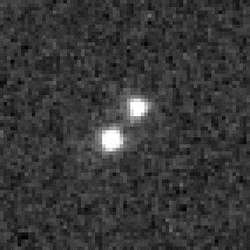(524366) 2001 XR254
(524366) 2001 XR254, provisional designation 2001 XR254, is a trans-Neptunian object and binary system from the classical Kuiper belt, located in the outermost region of the Solar System. The cubewano belongs to the cold population and measures approximately 171 kilometers (110 miles).[7] It was first observed on 10 December 2001, by astronomers at the Mauna Kea Observatory, Hawaii. Its 140-kilometer sized companion was discovered by the Hubble Space Telescope in June 2006.[6]
 Hubble Space Telescope image of 2001 XR254 and its satellite, taken in 2007. | |
| Discovery [1][2] | |
|---|---|
| Discovered by | D. C. Jewitt S. S. Sheppard J. Kleyna |
| Discovery site | Mauna Kea Obs. |
| Discovery date | 10 December 2001 |
| Designations | |
| (524366) 2001 XR254 | |
| 2001 XR254 | |
| TNO [3] · cubewano [4][2] cold [5] | |
| Orbital characteristics [3] | |
| Epoch 27 April 2019 (JD 2458600.5) | |
| Uncertainty parameter 4 · 3[1] | |
| Observation arc | 14.26 yr (5,207 d) |
| Aphelion | 44.374 AU |
| Perihelion | 41.178 AU |
| 42.776 AU | |
| Eccentricity | 0.0374 |
| 279.78 yr (102,188 d) | |
| 226.02° | |
| 0° 0m 12.6s / day | |
| Inclination | 1.2309° |
| 180.01° | |
| 78.868° | |
| Known satellites | 1 (D: 140 km; P: 125.58 d)[6][7] |
| Physical characteristics | |
Mean diameter | 221+41 −71 km (combined) 171+32 −55 km (primary) |
| Mass | (4.055±0.065)×1018 kg[7] |
Mean density | 1.00+0.96 −0.56 g/cm3[7][lower-alpha 1] |
| 0.136+0.168 −0.044[7] | |
| V−I = 1.06±0.12[6] | |
| 5.7[1][3] 6.05[8] | |
Discovery and orbit
2001 XR254 was discovered on 10 December 2001 by David C. Jewitt, Scott S. Sheppard and Jan Kleyna using 2.2-meter University of Hawaii reflector on Mauna Kea.[2] 2001 XR254 belongs to the dynamically cold population of the classical Kuiper belt objects, which small orbital eccentricities and inclinations. Their semi-major axes reside mainly in the interval 40–45 AU.[7]
Satellite
2001 XR254 is a binary consisting of two components of approximately equal size. Assuming that both components have the same albedo, the primary is estimated to be about 170 km in diameter. The size of the secondary (satellite) in this case is estimated at about 140 km. The total mass of the system is about 4×1018 kg. The average density of both components is about 1 g/cm3.[7]
| Semi-major axis (km) | Eccentricity | Period (d) | Inclination (°) |
| 9310 ± 49 | 0.5561 ± 0.0046 | 125.579 ± 0.049 | 41.07 ± 0.22 |
Numbering and naming
This minor planet was numbered by the Minor Planet Center on 18 May 2019 (M.P.C. 114619). As of 2019, it has not been named.[11]
Physical properties
The surfaces of both components of 2001 XR254 appear to have a neutral color.[8]
Notes
- Assuming that both components have equal albedos and equal densities
References
- "2001 XR254". Minor Planet Center. Retrieved 3 December 2018.
- Marsden, Brian G. (1 November 2002). "MPEC 2002-V07 : 2001 XR254, 2001 XS254, 2001 XU254". IAU Minor Planet Center. Harvard-Smithsonian Center for Astrophysics. Retrieved 3 December 2018.
- "JPL Small-Body Database Browser: (2001 XR254)" (2016-03-13 last obs.). Jet Propulsion Laboratory. Retrieved 3 December 2018.
- Marc W. Buie. "Orbit Fit and Astrometric record for 01XR254". SwRI (Space Science Department). Retrieved 17 February 2018.
- Brown, Michael E. "How many dwarf planets are there in the outer solar system?". California Institute of Technology. Retrieved 3 December 2018.
- Johnston, Wm. Robert (23 June 2015). "Asteroids with Satellites Database – 2001 XR254". Johnston's Archive. Retrieved 3 December 2018.
- Vilenius, E.; Kiss, C.; Mommert, M.; Müller, T.; Santos-Sanz, P.; Pal, A.; et al. (May 2012). ""TNOs are Cool": A survey of the trans-Neptunian region. VI. Herschel/PACS observations and thermal modeling of 19 classical Kuiper belt objects". Astronomy and Astrophysics. 541: 17. arXiv:1204.0697. Bibcode:2012A&A...541A..94V. doi:10.1051/0004-6361/201118743.
- Vilenius, E.; Kiss, C.; Mommert, M.; Müller, T.; Santos-Sanz, P.; Pal, A.; et al. (May 2012). ""TNOs are Cool": A survey of the trans-Neptunian region. VI. Herschel/PACS observations and thermal modeling of 19 classical Kuiper belt objects". Astronomy and Astrophysics. 541: 17. arXiv:1204.0697. Bibcode:2012A&A...541A..94V. doi:10.1051/0004-6361/201118743.
- Grundy, W. M.; Noll, K. S.; Buie, M. W.; Benecchi, S. D.; Stephens, D. C.; Levison, H. F. (April 2009). "Mutual orbits and masses of six transneptunian binaries". Icarus. 200 (2): 627–635. arXiv:0812.3126. Bibcode:2009Icar..200..627G. doi:10.1016/j.icarus.2008.12.008.
- Grundy, W. M.; Noll, K. S.; Nimmo, F.; Roe, H. G.; Buie, M. W.; Porter, S. B.; et al. (June 2011). "Five new and three improved mutual orbits of transneptunian binaries". Icarus. 213 (2): 678–692. arXiv:1103.2751. Bibcode:2011Icar..213..678G. doi:10.1016/j.icarus.2011.03.012.
- "MPC/MPO/MPS Archive". Minor Planet Center. Retrieved 29 May 2019.
External links
- List of Transneptunian Objects, Minor Planet Center
- List of binary asteroids/TNOs, Johnston's Archive
- (524366) 2001 XR254 at AstDyS-2, Asteroids—Dynamic Site
- (524366) 2001 XR254 at the JPL Small-Body Database